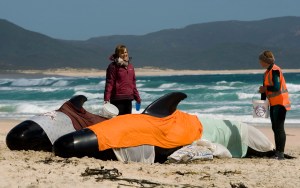 As authorities scrambled to pick up the pieces after a deadly earthquake hit the southern New Zealand town of Christchurch on Tuesday, government workers further south had just finished handling an altogether different kind of natural disaster. Over the weekend, more than 100 pilot whales were found on a remote beach on Stewart Island off the larger South Island. By the time the Department of Conservation reached them, half the stranded whales were dead, and the remaining live animals had to be euthanized.
As authorities scrambled to pick up the pieces after a deadly earthquake hit the southern New Zealand town of Christchurch on Tuesday, government workers further south had just finished handling an altogether different kind of natural disaster. Over the weekend, more than 100 pilot whales were found on a remote beach on Stewart Island off the larger South Island. By the time the Department of Conservation reached them, half the stranded whales were dead, and the remaining live animals had to be euthanized.
Whale strandings are not uncommon in New Zealand; a major stranding happens in the southern part of the country every 4 or 5 years, according to the Department of Conservation. Scientists around the world aren’t sure why whales beach themselves, but DOC spokesman Andy Roberts says in southern New Zealand, the two likely reasons are either that the pod has followed a sick animal on shore to help it, and become stuck in the shallow waters, or that the pod has made a navigational error and swam ashore. (He says there was no connection being made between the earthquake and the stranding.)
In many strandings, the animals can be rescued, and there are volunteer organizations in New Zealand who are on call to do just that. “It really depends how close you are to getting people and materials to the beach,” says Roberts. “If you can get people to them easily, you can do something. If you can’t get people to them, it’s just hard.” These whales, unfortunately, were 40 kilometers from the nearest road. After being put down, the 107 whales were left on the beach to decompose.
Since 1840 when New Zealand started to keep records on whale beachings, some 13,000 events have been recorded. As of 2006, 2000 whales had been rescued. New Zealand is thought to be particularly treacherous territory for whales because of the topography of its coast – jagged, and with gently sloping beaches that are thought to have some connection to this peculiar recurrence. Whale biology might also play a role, stranding themselves as they get sick and have their equilibrium thrown off, or compelling groups to follow sick pod members, as Roberts pointed out.
Among the theories, humans, too, play their part. Though Roberts says there is no connection in this stranding’s case, environmental groups in other parts of the world have argued that naval sonar equipment and ship noise pollution can cause whales to get confused and get off course. As whale strandings have been increasing in the U.K., where at least 500 whales beached themselves in 2010, local groups have been investigating the events’ connection to sonar equipment used by the Royal Navy. In 2005, some claimed that submarine naval exercises off the Outer Banks in North Carolina led to the beaching of nearly 20 whales along the Cape Hatteras National Seashore.
The U.N., NOAA and the International Whaling Commission (IWC) have all suggested in reports that the naval military equipment and strandings may be linked, and the National Resources Defense Council, an American environmental group that links at least 13 mass strandings to naval exercises in recent years, has been pushing for sonar use that is safer for animals in the U.S. A case that the NRDC filed against the Navy to adopt safety measures to protect ocean mammals went all the way to the Supreme Court in 2008, which issued a split decision requiring the Navy comply with some of the measures, which it did.
The notion of whether or not whale strandings could have something to do with climate change has also been tabled. As ocean temperatures get warmer, some suggest that it may be driving whales into unfamiliar territory that they aren’t able to navigate as well. Could this year’s funky weather in the South Pacific, with a strong La Nina in force, have contributed to the Steward Island stranding? Past studies have suggested it could be so. In a 2005 paper, scientists in Australia studied the links between weather patterns and whale strandings in the 20th century, finding that large-scale weather events had a powerful role in influencing whales to beach themselves.


